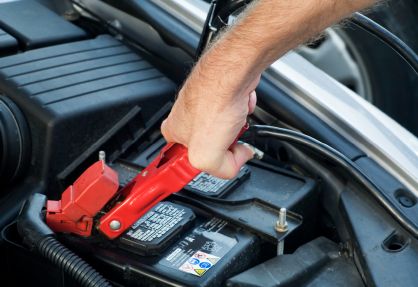I often take for granted the one skill I grew familiar with about ten years ago: troubleshooting.
Troubleshooting doesn’t need to involve computers, but for me, it turned out that way. Troubleshooting is borne out of my fascination with understanding how systems work, why they work, and how they can be improved.
I’d say that it all started five years earlier when I had trouble getting signed onto America Online 3.0. After being beholden to AOL’s technical support in the nineties, I realized that I should have been the one to solve these issues.

I’ll share with you a non-technical story on why troubleshooting is important.
You wake up and get in your car. You stick the key in the ignition and try to crank it over. You are then met with “Bzzzzt!” Then you try again unsuccessfully a couple more times, “Bzzzzt! Bzzzzzzzzzt!” At this point, you quickly deduce that it probably has something to do with your battery. If you are lucky enough, you have a neighbor or a friend with a running car and a pair of jumper cables and you can jump-start your car. Otherwise, you’ll ring up AAA or a towing service to start your car.
The fact that you isolated the cause of the battery is one example of troubleshooting. But it doesn’t stop there …
Continuing the same scenario, assume you were able to successfully jump-start your car. At this moment, you figure that the battery went dead, but it’s okay now because you got to your destination and it won’t be a problem.
Later that day, you got hungry and decided to go out for lunch. You return to your car, stick the key in the ignition, turn your key with the hope that it turns over. Unfortunately, your car made this yet another futile attempt to drive reliably by producing the same sound, “Bzzzzt! Bzzzt!”
Now, you’re concerned. You might get by with another jump-start, but you’re probably thinking about buying a new battery. The feeling of engaging in a scary conversation with a service advisor at the dealership (aka, “stealership”) consumes you. Do you need a battery from the manufacturer or will a Duralast one from AutoZone work fine?
In a panic, you get your car towed to the dealership (because we tend to make our best decisions while panicked). I’m going to assume that you have to tow services from your insurance company, so I assume it’s free.
Once at the stealership, the service advisor tells you that you need a new battery and an alternator.
After spending $400, you get back in your car and drive away. You get back home and after taking a nap after surviving the stealership, you decide to go out again.
Your car continues with its “Bzzz! Bzzzz!” leaving you stranded — again.
After towing your car back to the stealership, you’re livid. You just paid them to fix it and now it’s broken. Once you’re there, the service advisor promises to have one of the technicians do a full diagnostic on it.
A half-hour later, the service advisor comes to you with a straight face and says they found the issue, but it wasn’t the battery or the alternator. It was a malfunctioning radiator fan. In their explanation, they state that the fan wasn’t turning and it was actually shorted out and your car has a safety mechanism to keep supplying the fan electricity for 15 minutes when the car is off if the engine is hot. Therefore, the fan was sucking away the power from the battery, causing the dead battery.
Since the service advisor realizes your frustration, they waive the labor charges, and you have to fork over another $80 for the fan and wait another hour or so for the technician to install it. Then you reluctantly drive away hoping the problem doesn’t return.
Luckily, from this point on, your car continues to start normally and you have no further problems.
After this very plausible experience, nearly $500 later, you learned a valuable lesson about the practicality and benefit of proper troubleshooting. While it is completely possible that the battery was dead or that the diodes in the alternator were deteriorating, neither was proven beyond a reasonable doubt to be the cause. In fact, those components were simply exhibiting the symptoms from the actual cause – a faulty fan motor.
It’s reasonable and expected that you would have had to only pay about $120 to replace the fan motor and not almost $500.
By following a disciplined “five whys” exercise, you can reliably determine the issue that needs to be fixed. Simply ask yourself “why” five times until you get to the root cause. When you don’t follow this exercise, you will throw parts, time, and money at a problem and still not have it fixed.
- Why doesn’t the car start? Check the battery and connections.
- Why doesn’t the battery have any power? Bench test the battery to determine if it can hold a charge. It does, so you put it back in the car.
- Why doesn’t the battery retain a charge? It does, once the car was jump-started, the alternator outputs at 14.7V and stays strong even with the headlights on. However, when the car is off, you find that the voltage is dropping– something is drawing power from the battery.
- Why is power being drawn from the battery? Yes, in fact, the car supplies power to the 12V socket in the console that is hot at all times and the car uses an electric radiator fan on the same circuit. Quickly tested the 12V socket by charging an iPhone in the car and it works.
- Why isn’t the electric fan working properly? In this example, it was a short circuit in the fan motor.
While this line of questioning should always be applied by automotive technicians, as a consumer, it’s important to also ask these questions. They should tell you with a high degree of detail what they tested, what was the expected output, what was the actual output, and even voluntarily offer to show you the proof. Even if you don’t know the problem, asking questions is perfectly fine and they should keep you informed. And if something doesn’t make sense, ask them to explain it again. You really shouldn’t take them on their word and blindly pay for services you aren’t fully educated and informed about.
When being faced with a mechanical challenge, be it your vehicle or even something as technical as WordPress, be sure to ask “why?” five times to discover why an expected outcome is not occurring. This will help you properly diagnose the cause so you can apply the proper solution. No matter what we’ve been told in the past, cars (and WordPress) aren’t possessed. There’s usually a good reason for why they act up.
In my next post, we’ll explore the innards of troubleshooting WordPress and how to reasonably isolate most problems without losing your cool.
Photo Credit: AndyArmstrong; 24 Hr Auto Repair


